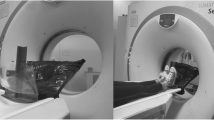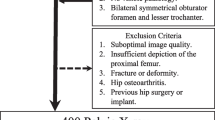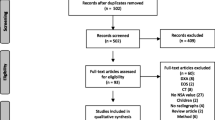Abstract
Objective
To compare two methods of measuring femoral neck anteversion angle (FNA): A 2D method used at Odense University Hospital until 2010, and a method labeled 3D-OUH. The latter method makes corrections to compensate for errors introduced by the individual placement of patients in the CT scanner.
Materials and methods
Twenty-six CT-examined patients were included: nine men and 17 women. The right side FNA was measured twice with each method by one observer, measuring intraobserver variability. Both methods are based on the following anatomy: femoral head center, center at the level of lesser trochanter and posterior apex of the femoral condyles. The 3D-OUH method corrects for the individual orientation of femur by realigning it prior to measurement, in accordance to Murphy et al.’s original definition of FNA. The intercondylar notch center of the knee and center at lesser trochanter was used in the realignment.
Results
The 2D method significantly overestimated FNA compared to 3D-OUH by 4.2° (95 % CI: 2.8°; 5.6°), p < 0.0001. All measurements with the 3D method needed clock-wise correction in the coronal plane, suggesting patient positioning as a consistent source of overestimation by the 2D method. The 3D-OUH method had a lower intraobserver variability with a limit of agreement (LOA) of −2.4° to 2.1° against that of the 2D method of −3.4° to 3.8°
Conclusions
Mean anteversion was 4.2° (95 % CI: 2.8°; 5.6°) lower with the 3D-OUH method than with the 2D method. The 3D-OUH method eliminated an obvious source of error, namely the individual orientation of femur during CT-examination. Moreover, intraobserver variability was improved with the 3D-OUH method.










Similar content being viewed by others
References
Billing L. Roentgen examination of the proximal femur end in children and adolescents. Acta Radiol Suppl. 1954;110:1–80.
Murphy SB, Simon SR, Kijewski PK, Wilkinson RH, Griscom NT. Femoral anteversion. J Bone Joint Surg Am. 1987;69(8):1169–76.
Hermann KL, Egund N. CT measurement of anteversion in the femoral neck–the influence of femur positioning. Acta Radiol. 1997;38:527–32.
Sugano N, Noble PC, Kamaric E. A comparison of alternative methods of measuring femoral anteversion. J Comput Assist Tomogr. 1998;22(4):610–4.
Kim JS, Park TS, Park SB, Kim IY, Kim SI. Measurement of femoral neck anteversion in 3D. Part1: 3D imaging method. Med Biol Eng Comput. 2000;38(6):603–9.
Kuo TY, Skedros JG, Bloebaum RD. Measurement of femoral anteversion by biplane radiography and computed tomography imaging: comparison with an anatomic reference. Investig Radiol. 2003;38(4):221–9.
Lee YS, Oh HS, Seon JK, Song EK, Yoon TR. 3D femoral neck anteversion measurements based on the posterior femoral plane in ORTHODOC-system. Med Biol Eng Comput. 2006;44(10):895–906.
Bland JM, Altman DG. Statistical methods for assessing agreement between measurement. Biochim Clin. 1987;11:399–404.
Bland JM, Altman DG. Agreement between methods of measurement with multiple observations per individual. Biochim Clin. 2007;17(4):571–82.
Pulisetti TD, Onwochei MO, Ebraheim NA, Humphries C, Coombs RJ. Mathematical precision in rotational corrective osteotomy of the femur. J Orthop Trauma. 1998;12(5):360–2.
Tönnis D, Heinecke A. Diminished femoral antetorsion syndrome: a cause of pain and osteoarthritis. J Pediatr Orthop. 1991;11(4):419–31.
Acknowledgments
For providing valuable statistical counseling, we thank Jens Lauritsen, Consultant, PhD, Accident Analysis Group, Odense University Hospital and senior statistician Oke Gerke, Ph.D, Department of Nuclear Medicine, Odense University Hospital.
Conflicts of interest
The authors declare that they have no conflict of interest.
Author information
Authors and Affiliations
Corresponding author
Rights and permissions
About this article
Cite this article
Olesen, T.H., Torfing, T. & Overgaard, S. MPR realignment increases accuracy when measuring femoral neck anteversion angle. Skeletal Radiol 42, 1119–1125 (2013). https://doi.org/10.1007/s00256-013-1639-y
Received:
Revised:
Accepted:
Published:
Issue Date:
DOI: https://doi.org/10.1007/s00256-013-1639-y




